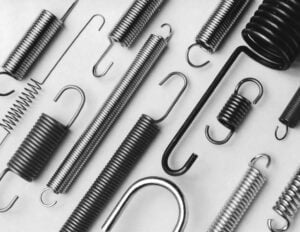With hooks on both ends, extension springs attach to two components in an application and resist tensile forces, elongating as those components pull away from one another. An extension spring stores energy as it elongates creating a pulling force between the components.

Extension springs are used in many common and industrial applications, including:
- Farm equipment
- Fence gates
- Garage doors
- Tools (e.g., vise-grip pliers)
- Sporting Equipment
- Medical Equipment
- Aerospace components
Key Considerations for Custom Extension Spring Design
When designing a custom extension spring, you will want to consider these factors.
1. Preventing excessive stress is critical to an extension spring’s longevity
While preventing stress is important when designing any spring, it is especially critical for custom extension springs. When a spring is overstressed, it may yield or become distorted. The same extension spring may work well in one application, but can be overstressed in another application requiring additional deflection, also known as “travel distance”.
Wire diameter, coil diameter, body length, and maximum travel all play key roles in extension spring stress.
2. End type and hook position affect extension spring stress
The end type, or the way the hook is attached to the end of the spring, also affects spring stress. In fact, the most common point of failure for extension springs is the location where the hook bends away from the spring. One way to minimize spring stress is to design an end type featuring a gradual (rather than a sharp) radius.
Additionally, consider whether your hook placement is fixed or could be modified slightly. If there is flexibility regarding where the hook is attached, we can extend hook length with a larger bend radius away from the coil body.
3. Initial tension factors into extension spring rate calculations
It is important to factor initial tension into your design to achieve your desired spring rate—the ratio of pounds per inch of deflection.
Initial tension—the force keeping the spring’s coils together—is the amount of tension that exists in the spring itself. The initial tension is overcome when enough force is reached to deflect the spring and you can see light passing between the coils.
4. Extension springs should be baked immediately after plating
Many custom extension springs do not require surface finishing. However, if you need plating, we almost always recommend following it up with a baking process.
Extension springs that are not properly baked after plating are prone to hydrogen embrittlement, which can reduce cycle life and result in spring failure.
5. Designing tight tolerances will increase manufacturing costs
While tight tolerances may be essential to the function of your spring, keep in mind that achieving tight tolerances requires more extensive processes and can increase manufacturing costs.
If you are unsure about the ideal tolerance specifications for your custom extension spring, we are happy to point you toward industry standards for tolerancing these types of springs.
Custom Extension Spring Manufacturing at Gifford Spring Company
At Gifford Spring Company, we manufacture custom extension springs in wire diameters from 0.010” to 0.148”. We welcome questions from our customers throughout the design process and are pleased to help you choose the best material, end type, or hook position for your spring.
Request a quote today, and let’s collaborate on your design.